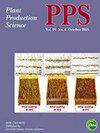基于神经网络的两个水稻品种“Koshihikari”和“Takanari”冠层温差预测及其环境响应估计
IF 1.3
3区 农林科学
Q2 AGRONOMY
引用次数: 0
摘要
摘要冠层光合作用是水稻(Oryza sativa L.)生物量生产的重要组成部分。尽管冠层温差(CTD)为评价冠层光合作用提供了重要信息,但其测量仍然是一项劳动密集型任务。因此,我们设计了这项研究,利用气象数据建立了一个预测不同现场条件下CTD的模型,并使用所建立的模型评估了CTD的环境响应。我们的研究从两个具有不同光合能力的水稻品种“Koshihikari”和“Takanari”收集了2056264个CTD数据点,然后使用这些数据使用神经网络(NN)创建了一个新的模型。输入变量仅限于气象数据,输出变量设置为CTD。所建立的NN模型的预测精度为R2=0.792,RMSE=0.605°C。然后,我们使用该NN模型模拟Koshihikari和Takanari品种对各种环境变化的CTD响应。这些预测表明,当暴露在高相对湿度(RH)或中低太阳辐射(Rs)下时,Takanari的CTD比Koshihikari低。相反,在较低的RH或较高的Rs下,Koshihikari的CTD往往低于Takanari。这一结果表明,在极高的VPD条件下,Takanari的单叶片气体交换系统的优势可以得到缓解。因此,我们的新方法可能为更好地了解田间条件下种植的水稻的气体交换、生长过程和品种差异提供一个强有力的工具。图形摘要本文章由计算机程序翻译,如有差异,请以英文原文为准。
Predicting rice (Oryza sativa L.) canopy temperature difference and estimating its environmental response in two rice cultivars, ‘Koshihikari’ and ‘Takanari’, based on a neural network
ABSTRACT Canopy photosynthesis is an important component of biomass production in field-grown rice (Oryza sativa L.). Although canopy temperature differences (CTD) provide important information for evaluating canopy photosynthesis, the measurement of CTD is still a labor-intensive task. Therefore, we designed this study to establish a model for predicting CTD under different field conditions using meteorological data and evaluated the environmental response of CTD using the established model. Our study collected 2,056,264 CTD data points from two rice cultivars having different photosynthetic capacities, ‘Koshihikari’ and ‘Takanari’, and then used these data to create a novel model using a neural network (NN). The input variables were limited to meteorological data, and the output variable was set to CTD. The established NN model produced a prediction accuracy of R2 = 0.792 and RMSE = 0.605°C. We then used this NN model to simulate the CTD response of the Koshihikari and Takanari cultivars in response to various environmental changes. These predictions revealed that Takanari had a lower CTD than Koshihikari when exposed to high relative humidity (RH) or low to moderate solar radiation (Rs ). In contrast, the CTD of Koshihikari tended to be lower than that of Takanari under lower RH or higher Rs . This result implies that the advantages of the single-leaf gas exchange system in Takanari can be mitigated under extremely high-VPD conditions. Thus, our new method may provide a powerful tool to gain a better understanding of gas exchange, growth processes, and varietal differences in rice cultivated under field conditions. Graphical Abstract
求助全文
通过发布文献求助,成功后即可免费获取论文全文。
去求助
来源期刊

Plant Production Science
农林科学-农艺学
CiteScore
5.10
自引率
4.00%
发文量
27
审稿时长
>36 weeks
期刊介绍:
Plant Production Science publishes original research reports on field crops and resource plants, their production and related subjects, covering a wide range of sciences; physiology, biotechnology, morphology, ecology, cropping system, production technology and post harvest management. Studies on plant production with special attention to resource management and the environment are also welcome. Field surveys on cropping or farming system are also accepted. Articles with a background in other research areas such as soil science, meteorology, biometry, product process and plant protection will be accepted as long as they are significantly related to plant production.
 求助内容:
求助内容: 应助结果提醒方式:
应助结果提醒方式:


